Explore the world of Concorde with Heritage Concorde
Please note - B2 Engineer Ricky Bastin who was formerly associated with Heritage Concorde is no longer part of the group
Between January and September of 2011, following an intensive period of secret work carried out by Steve de Sausmarez, Ian Mosdell and Ricky Bastin, British Airways Concorde G-BOAC was returned to life by our team, Heritage Concorde. Heritage Concorde engineers who were actually in the process of carrying out a series of repairs during this time to Concorde G-BOAC, which is currently stored and open to the public at Manchester Airport. This project was solely carried out in secret by this team, without the involvement or knowledge of any other groups outside of Manchester. The absolute requirement of secrecy was so obvious and understandable, when you consider that the team were powering up the UK Concorde systems for the first time since 2003.


Project Background
Due to the list of repairs required to the aircraft, our major requirement was for that of a B1 engineer, as he would process the knowledge regarding the airframe, this would include hydraulic systems, nose and visor repairs, windscreen, DV window, and accumulators. So this meant that Ian’s role in the whole project was central to its success. But for the power-up we required a B2 engineer, this role was filled by Ricky Bastin who came up with the idea of powering up of the aircraft systems to allow the nose and visor to be moved, a requirement if replacing the windscreen.
Other members soon joined these three on the project, both at the start and over the following months, no matter what role each one played in the project, all team members were key to the success of the project.
The whole project really got off the ground following a visit to the museum by Steve de Sausmarez, along with his brother and Pete Meesum, back in January 2011. On seeing the situation regarding the damage to the aircrafts windscreen and visor, Steve de Sausmarez (Who was at the time head of Heritage Concorde) offered some help to Sue and Ross Williamson at Manchester; he made it very clear to everyone at Manchester that there were no promises, but he would try his best to get a team of former engineers together who would be interested in repairing the aircraft, and to locate the parts.
On returning home, he at once started contacting and recruiting engineers to the project, his next task was to source spare parts.
Steve returned to Manchester two days later to discuss with Ross and Sue the progress and possible outcome of the future project.
The first engineer to accept the request for help was certified British Airways Engineering B1 engineer and highly respected legendary former Concorde engineer Ian Mosdell.

Steve De Sausmarez - Former head of Heritage Concorde and Project Flagship Co Ordinator
Steve de Sausmarez and Ricky Bastin (who was to head the power-up of the aircraft) set off to Manchester during February and together held a meeting with the museum management, where the HCT (Heritage Concorde Tech) team received a massive YES to the requested power-up of G-BOAC.
Now they had a project that had the green light and for the first time since 2003 would in fact make some real progress with a British Concorde, no other British group had got this far before or even had their hands on a live Concorde. The team gave themselves the nickname of the ‘S’ Team (‘S’ standing for supersonic).
Project Flagship was now underway, and no one else outside of the HCT team and Manchester airport even had a clue as to what the Heritage Concorde team were going to do.
What must be stated at this point is the importance of the role played by Ross Williamson. It would be a total injustice not to acknowledge his central role at Manchester, without the involvement of Ross, there wouldn’t have been a Project Flagship, or a live UK Concorde.
Project Flagship founder Steve de Sausmarez (who project managed the whole project) Following the gathering of the first key members of the team, the next stage of the project was to persuade Manchester Airport to allow the aircraft to have power restored to it.

Concorde G-BOAC was restored back to life for the first time on the 14th March 2011, when Steve de Sausmarez, was given the chance to move the Ground Power Protection switch to close. Steve not only founded the project in the first place, but also carried out the complex project management of the project.
As well as powering-up Concorde, the group repaired a broken visor panel, a DV window and carried out various other repairs to the aircraft. Power was restored to the aircraft on several occasions, but apart from the first power-up on the 14th March and last power-up on the 26th August, which was the longest and lasted for over five hours, all other power-ups were failures due only to problems with GPUs and the GPU exhaust extraction, there were no problems with the aircraft during any power up procedures.
Sadly on the 1st September 2011, the project received a red light and the whole thing came to a massive halt due to Health and safety concerns. I won’t tell you how that felt for the whole team, and after months of hard work for all involved, and before the team could complete all the required repairs to the aircraft, and go public too.
The team received support from various other individuals and organizations as detailed below we would like to thank all these people for supporting the project.
-
Richard Carr and his team at GKN, Birmingham UK – Windscreen replacement repair
-
Swissport at Manchester Airport, UK – Free loan of a GPU
-
The University of Dayton, USA – Research into a replacement hydraulic fluid for Concorde
-
Robin Voice at Brooklands Museum, UK – Free loan of a tyre inflation rig
-
Gordon Roxburgh and the Concorde Team – Brooklands Museum, UK – Supply of the new visor panel and the windscreen
-
Colin Harris – Former manager of the museum at Manchester
-
Peter Meesum – Engineering advice and later a full member of the of the team
-
Philip Morris – Background support
-
Ross Williamson – Major support, and really part of the team
-
Natalie Kelly – Museum manager and a major force in the whole project
-
Andrew Gunther – Background support
-
Beth Brewster – The driving force on the Manchester side, and a really wonderful supporter of the repairs
-
Eddie Armsden – Background support
What now follows is a full listing of all the repairs and tasks that were carried out to the aircraft, by the Heritage Concorde team between Monday March 14th and Friday August 26th 2011. If you would like to ask any question relating to these repairs and tasks, you will find the team on our Facebook group, click on the link at the bottom of this page.
DV window repair
The Heritage Concorde engineering team were informed that the DV window had been removed from the aircraft as it had been damaged by a former employee at Manchester; the damage had caused the DV window to actually fall out of position, and therefore forced its removal from the aircraft for both safety and to prevent further damage. Following the inspection by Concorde B1 Engineer Ian Mosdell, it was identified that the operating mechanism had been completely wrecked, also that the rollers had been lost.
Steve de Sausmarez had a friend, Pete Meesum manufacture new DV window rollers, these were based on drawings by Ian Mosdell, and were manufactured by Pete in stainless steal. They were sadly never fitted to the aircraft, which was due to the conclusion of the project by the airport prior to their delivery.


Ian managed to relocate the window in its mountings; all that is now required to complete this task, are of course the rollers and some bolts (the original bolts had already been lost before Concorde Project Flagship began). These bolts will allow the new rollers to be fitted to the aircraft and the task therefore will be completed.
Heritage Concorde has these new rollers in storage for any future repairs; they will at that point be handed over to any future team.
Pete Meesum joined the team at this stage and played an important role in the power-up of the aircraft, without Pete we would have been left with a series of failed power-up’s of the aircraft, more about his major role under the heading relating to the power-up the aircraft during this project.
Pete Meesum

The repair of the engine re-heat switches
One of the former museum employees had also caused damaged to aircraft’s re-heat switches, which are located on the centre console panel on the flight deck.
It seems that they had been glued together and wood screws jammed in underneath the surface of the switches for some strange reason, known only to the person that had carried out this damage.
After quite a long struggle Ricky Bastin was able to free the switches and remove the wood screws. The switches were then checked to ensure that they would operate correctly in the future, but it was found that they would require replacement.

The curved visor replacement - 18 July 2011
The biggest problem was finding a replacement visor panel for G-BOAC. In the end after a lot of research Steve de Sausmarez managed to locate one amongst the spares at Brooklands museum, with the help of the Brookland Concorde team. He then arranged for the supply, collection and delivery of the part to Manchester airport.
The task of fitting the new visor to the aircraft was a extremely time consuming process. Removing all the screws that were required to be removed from the visor was very difficult, as it was possible that these securing screws may have been actually in place for at least 10 years, and many had also been damaged by the use of incorrect tooling during a previous attempt which was made to remove them by an employee of the museum at Manchester.
B1 Concorde engineer Ian Mosdell, who was assisted by others, including Ricky Bastin, Ross Williamson and Steve de Sausmarez, worked all day until nearly 8pm in the evening to complete this task.
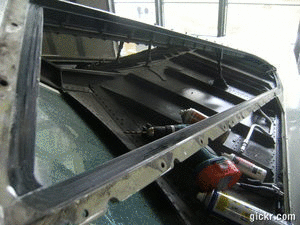

The replacement visor panel supplied by Brooklands
The first job for the Ian and the team was to remove the small side window in order to gain access to the securing frame of the visor panel, the small one is hinged (See the diagrams below) and can be opened once certain screws are removed. The rest of the visor panel frame was then removed and the broken visor panel was electrically disconnected and removed from the aircraft, this was passed through the DV window to Steve who removed it from the aircraft. The new panel which had been donated by Brooklands museum and which had been collected by Steve and others from Manchester, was then connected and fitted to the frame and then following this task, the side window was refitted to the visor.


The replacement visor panel is now installed
Ian Mosdell and the rest of the team did a fantastic job of replacing the panel, another job ticked off the list and the result was a much better display for visitors to the aircraft.
Recharging the accumulators -8th August 2011
The engineers stated that before the B1 engineer Ian Mosdell could restore the aircrafts green hydraulic systems, which would allow Heritage Concorde to move the nose and visor during a power-up of the aircrafts systems.
This would be done to gain access to the broken windscreen securing screws, the process would required the team to recharge with the four accumulators with nitrogen.
This was necessary in order to try and reclaim as much of the M2V fluid still remaining onboard the aircraft as possible.
These accumulators are charged with nitrogen, and therefore this presented Steve de Sausmarez with another task, the acquirement of nitrogen, which after two weeks of messing around over the phone, it arrived at Manchester ready for the team to start work.
After many efforts the team accomplished this task on the 8th August 2011, this was also with the help of Brooklands museum as they supplied the charging rig which they loaned us and therefore allowed the team to use the two nitrogen bottles.
Although the team recharged all four accumulators on the aircraft, not as much fluid was reclaimed by the team as was hoped.


The accumulators

Pete Meesum
The main landing gear tyres – 8th August 2011

The aircraft tyres were in a poor condition; in fact they had a pressure of only 20psi. and appeared to look as if they were completely flat, they had not been inflated for approximately 18 months. This lack of action would have resulted in permanent damage to the tyres, and obviously they needed inflation. What you have to remember is that the total aircraft weight would have been pushing down on these tyres over these 18th months, and therefore weakened them. Another problem that hadn’t been addressed by Manchester is that these tyres need to be turned. The tyres were filled with nitrogen and the pressure in the bottles was 3000psi. The tyres were not fully inflated to the flight status pressure, as it wasn’t worth damaging the tyres.

Tail fin rudder clamps -18th July 2011
On the 18th July 2011, while the team had a scissor lift at their disposal. Ian Mosdell and Steve de Sausmarez used it to jointly access the tail fin of the aircraft and removed the two nasty looking rudder clamps.
These were fitted to the aircraft while it was stored outside to prevent the two rudders moving in the wind, but were no longer required as the aircraft was now stored inside a purpose built hangar at Manchester.

Steve De Sausmarez helps remove the clamps


G-BOAC with the clamps removed

Heritage Concorde engineer Ian Mosdell
Repair of the spare replacement windscreen – June to October 2011
The biggest problem with replacing the windscreen on the aircraft was that there was only one spare which was stored at Brooklands.
This spare had a two cracks in one of the outer glazing panels, and therefore unsuitable as a replacement part for G-BOAC.
Richard Carr at GKN in Birmingham agreed to repair this spare windscreen for the project, and for free too.
Steve de Sausmarez arranged for its collection from Brooklands, and then he delivered it to GKN.
This was no easy task for the team at GKN, the risks with regard to the other four glazed panel becoming damaged during the process were large indeed.
This sort of repair would never have happened during the service life of Concorde, the windscreen would have been simply been scraped and a new one at a cost of £25,000 supplied and fitted to the aircraft.

The shattered windscreen on G-BOAC
Richard made several phone calls to Steve de Sausmarez, and it was decided rather than slicing the panel off, that it would be better to shatter it and remove the pieces one by one, it worked and the panel was fitted with a new glazed panel.
The reason we took this approach rather than getting the one that was already damaged onboard the aircraft repaired, was due to the mess that the aircraft would be left in during the weeks that it would take to carry out the repair.
We simply just didn’t want to leave the nose and visor lowered and a hole in the aircraft where the windscreen was fitted.


The Hydraulic systems – 26th August 2011
Heritage Concorde Tech engineers discovered that more hydraulic fluid was going to be required before they could use Green systems. This now presented another problem to the team, which I guess involved more time in the background than any other project related problem.
Concorde also used a special hydraulic fluid, Chevron M2-V; this is no longer manufactured and therefore could not be purchased as in the case with the fluid used on other airliners. M2-V is a mineral based fluid, as opposed to the ester based Skydrol, used by the subsonic airliners. M2-V, is a high temperature fluid of the POLYSILOXANE (Ester Silicate) type, and able to resist temperatures ranging from – 60° C (- 76° F) to + 2300 C (+ 446° F) and having a sufficiently high bulk modulus.
The reason that they went for a different fluid such as M2V was a simple one; Skydrol is useless at the high temperatures that Concorde operated at, in fact it’s no good at all, so they needed something better and in M2V they found the perfect fluid. Another interesting fact is that unlike Skydrol, that attacks paintwork, certain rubber seals, skin, engineer’s eyes etc., M2V is completely harmless you could even wash your hair in it, but I wouldn’t recommend it.
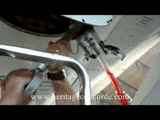
The oil is pumped in

Steve De Sausmarez on the ladder
A sample of the hydraulic fluid was taken from the aircraft by B1 engineer Ian Mosdell and Steve de Sausmarez during the first visit in March 2011, this was sent away for analysis. This analysis was carried out by Dayton University in Ohio, USA. The University of Dayton were very helpful and carried out tests.
The University carried out extensive studies and found that the fluid remaining M2-V to be in remarkably good condition, with very little contamination and extremely low water content.
The museum management kindly purchased 5 US gallons of Castrol Brayco fluid for use on G-BOAC, enough to fill the necessary tank (Green system).
Steve de Sausmarez drove to Harrow on the 25th August to collect this product and delivered it to Manchester on the 26th.On the 26th August 2011, as soon as we obtained the fluid, it was pumped into the aircraft using a locally charging pump made by Ian Mosdell and the whole team had a go at pumping in the new fluid it was amazing feeling.
Sadly we required further fluid and a pump failed, this pump meant that when the time came to pressurise the system, using the Green/Yellow ground pump, due to it being defective and of course this would need replacing in the future if the hydraulic system was to be pressurised, the whole plan to move the nose and visor was put on hold.
The temporary solution was to swap over the Green/Yellow (left wing) with the Blue/Yellow (right wing) ground pumps, enabling us to pressurise the Green hydraulic system and, therefore, lower and raise the nose of the aircraft, the plan was for Steve de Sausmarez and Ian Mosdell to carry out this task the following week, but the project was cancelled by the airport on the 31st August 2011, and therefore the project tasks ended on this day.
Please note we have since found Castrol Brayco oil is not an ideal replacement for M2V Concorde oil

The power-up of the aircraft - 14th March & 26th August 2011
After removing the avionics from the racks on the flight deck, following checks by the engineers and cleaning the dust away with a vacuum cleaner by other members of the team, which was carried out during a three hour period in the morning of the 14th March 2011.
The two engineers present on the day Ian Mosdell and Ricky Bastin finally restored electrical power to the aircraft for the first time in the afternoon after a break for lunch. There were no problems and the aircraft came back to life to the delight of all present. The engineers were very pleased with aircraft systems and commented how well this aircraft was built.
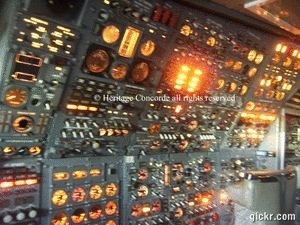
Some of the aircraft systems were isolated, to protect the aircraft from damage. Both engineers made sure that the fuel systems were isolated by pulling certain breakers, and after this, the equipment cooling system was activated to ensure that all avionic components would be cooled to ensure the safely of the aircraft.

GPU in hanger
After significant preperation Ian Mosdell cleans the Ground power connection on the outside of the aircraft and the GPU is brought into the hanger ready for connection to G-BOAC.
Only once both engineers are in agreement will the aircraft be powered.
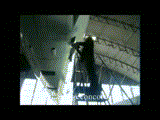
Ian cleans the connection

Ian plugs in the GPU

Ross starts the GPU

As the founder of the project and the head of Heritage Concorde, Steve de Sausmarez was granted the lucky task by the engineers to close the ground power switch and restore power to the aircraft for the first time on the 14th March 2011. This day marks the very first time Concorde G-BOAC was powered since 2003, and also the first time that a British Concorde was powered since November 2003.


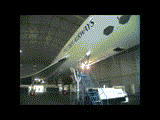

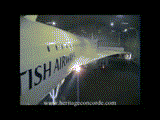


The hydraulic tank’s air compressor was then operated by the engineers in an effort to try and gauge the level of fluid in the three hydraulics systems. It was established by the engineers at this point that there was insufficient hydraulic fluid on the aircraft to enable the engineers to pressurise any of the systems.


The hydraulic tank’s air compressor was then operated by the engineers in an effort to try and gauge the level of fluid in the three hydraulics systems. It was established by the engineers at this point that there was insufficient hydraulic fluid on the aircraft to enable the engineers to pressurise any of the systems.
Following this power-up, there were subsequent failed attempts to power the aircraft which were due to many reasons, but none were conected to the aircraft in any way.
They were related to the situation with the GPU or lack and failure of a GPU and the exhaust fumes in the hanger.
Getting a good GPU and removing the fumes from the hanger was one of the biggest problems for us, but in the end Mr Pete Meesum sorted out the problems with exhaust and a local company at the airport allowed us to use one of their GPU’s, but to the delight of Ricky Bastin, as a long power-up allowed him to carry out some serious work on the flight deck.
The last power-up of Concorde G-BOAC – 26th August 2011
The only other successful power up came on the 26th August 2011, when the aircraft was powered for nearly six hours and this date also marks the very last time that the team were allowed to work on G-BOAC. But this success was really down to Pete Meesum who had solved the problem with the extraction and the efforts by Steve de Sausmarez to locate and obtain the correct GPU for free. The museums own GPU which was used on the 14th March had broken and therefore we had massive battles to obtain a GPU for free on each occasion.



For the records the engineers have tested the following systems…
Flight Deck Instrument Lighting
Intake Control Computers External Lighting
Inertial Navigation Systems
Air Data Computer System
Engine Control Computers
Autostab System
Flight Director System
Electric Trim System
VHF Communication System
Fire and Overheat Detection System
Fly by Wire Computer System

This picture was taken onboard a live G-BOAC at Manchester on the 26th August 2011: it shows all the red coloured push-button switches lit above the passenger seating which are on the passenger service units and a live flight deck in the distance too.
Aircraft inspections
The engineers also removed some of the access panels in the wings and other places to allow them to carry out inspections to the aircraft. These pictures were taken during these moments and clearly show the condition within the wings of G-BOAC. This is the first time since 2003 that engineers have been able to carry out such inspections to one of the British Airways Concordes.


With thanks to the Heritage Concorde ‘Project Flagship’ team.
Known to us at Heritage Concorde as the ‘S’ Team!
Ian Mosdell
Steve de Sausmarez
Ricky Bastin
Peter Meesum
Ian Kirby
Katie John
Ross Williamson
(Please note - B2 Engineer Ricky Bastin who was formerly associated with Heritage Concorde is no longer part of the group)

